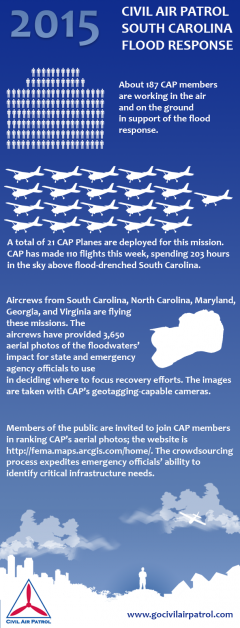Staff Sections
Main Content
Enhanced technology improves Civil Air Patrol’s flood damage assessment imagery
Three aircraft and crews conducting aerial damage assessment
10/10/2015–Columbia, South Carolina– Civil Air Patrol airmen photographing the flood damage in South Carolina began using a new tool Thursday in their emergency response arsenal – a Garmin Virb camera system that attaches to their planes’ wing strut. The cameras capture ground images directly below, which allows officials to make much faster use of the images.
South Carolina Wing officials received three of the new cameras Thursday from CAP’s National Operations Center at Maxwell Air Force Base, Alabama. They were first used on damage assessment flights last night.
About 187 CAP members have worked in the air and on the ground in support of the flooding response.
Aircrews from South Carolina, North Carolina, Maryland, Georgia and Virginia are flying under the direction of 1st Air Force at Tyndall Air Force Base, Florida. A total of 21 CAP planes have been deployed for the South Carolina mission.
Members of the public are invited to join CAP members in ranking the aerial photos; the crowdsourcing website is http://fema.maps.arcgis.com/home/. The crowdsourcing process expedites emergency officials’ ability to identify critical infrastructure needs.
CAP is also conducting search and rescue flights. So far, CAP has directed emergency officials to numerous vehicles in distress, located two unsafe bridges that had no law enforcement or other barricades and flown over roads in and out of Georgetown to help state emergency management plan for evacuations.
Sub Content
- My Account
- Member Login
- Register for an account
Search
- Recent Articles
- Cunningham Field Composite Squadron Hosts Air Operations Training and Familiarization
- NC Wing CyberPatriot Preliminary State Award Winners Announced
- Tar River Composite Squadron Cadets Compete in CyberPatriot Competition
- Civil Air Patrol Remembers Veterans for Christmas
